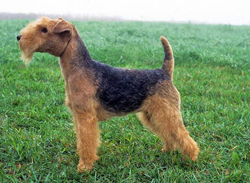The Lakeland Terrier is a small dog with a wiry, dense coat that comes in several colors, including black, blue, liver, wheaten, and red. Some dogs have a patch of color that falls over the back and shoulders and forms a "saddle." The outer coat is hard, while the undercoat is soft and close to the skin. The breed has small, oval eyes and V-shaped, small ears. The nose is black and the muzzle is strong, and these dogs have medium-length tails that point directly up. Lakeland Terriers measure 14.5 inches tall at the shoulder and weigh about 17 pounds.
Lakeland Terriers are not naturally timid or shy, and they should never be aggressive. These personality traits indicate a genetic issue or other serious problem.
These bold and friendly dogs are well suited for urban apartments or rural living, and they make excellent family companions. As an active breed, they need regular exercise, but they require minimal daily grooming. This makes them a perfect fit for active families.
Lakeland Terriers are easily identified by the spring in their step and their "top of the world" attitude. These dogs truly believe they are the greatest creature on the planet.
Lakeland Terriers are known for their bold, friendly, and confident attitudes. They are energetic and determined and love nothing more than spending time outdoors running, swimming, digging, and playing. They get along fairly well with other dogs (although there may be some issues if both are males), and they do well with families with children. The breed is not a huge fan of cats, however, and likely sees them as vermin to be chased and destroyed.
These dogs are adaptable and do well in apartments, provided they are allowed some outside time every day. They need daily exercise to prevent poor behavior stemming from pent up energy and boredom. The have a natural tendency toward mischief making and have a great sense of humor, traits that can result in hours of entertainment for the whole family.
Lakeland Terriers are not naturally timid or shy, and they should never be aggressive. These personality traits indicate a genetic issue or other serious problem. Working with a professional trainer may help correct these issues.
Lakeland Terriers are generally free of any serious health problems, but that is no guarantee that any individual dog will be free of disease throughout life. The breed is at increased risk for certain eye disorders, including distichiasis, lens luxation, cataracts, and glaucoma, although treatments are available to help manage these conditions.
Legg-Calve-Perthes disease, a bone disorder, and von Willebrand's disease, a blood clotting disorder, are other serious concerns in the breed. These conditions may require surgery or lifelong care to protect length and quality of life.
In the absence of serious disease, and with routine veterinary care, a healthy diet, regular exercise, and standard canine vaccinations, Lakeland Terriers can live up to 15 years.
Although they can be stubborn and independent, Lakeland Terriers are eager to please and they learn quickly, especially when the subject is an enjoyable one. However, the breed can be challenging to train, especially for first-time dog owners.
Training sessions should be short and fun, and these dogs respond much better to positive reinforcement, such as food and play rewards, than to harsh criticism or physical punishments. Socialization starting early in life helps ensure these dogs become tolerant, calm, and sensible adults. Later in life, trips to the dog park and walks around town ensure continued tolerance and prevent overly suspicious behavior from developing.
Like many other small breeds, the Lakeland Terrier can be difficult to housetrain. Patience and understanding are key, and eventually the breed will get the hang of it. One thing that may remain a problem is the breed's fondness for marking its territory. Training may help minimize this behavior.
Maintaining the breed's distinctive look requires regular grooming of its wiry coat and frequent clipping. The breed's feet and ears should be trimmed to improve appearance and help with cleanliness.
Bathing is rarely necessary, but if these dogs roll around in something sticky, stinky, or harmful, a pH-balanced canine shampoo should be gentle enough to clean the coat without drying the skin. Additionally, these dogs should be rinsed well after swimming in chlorinated pool water, saltwater, or algae-filled lakes.
The nails need trimming once every week or two, and the ears should be cleaned weekly and checked for odor, dirt, or excessive wax accumulation. If any signs of ear infection are present, a veterinarian should be consulted so that treatment can begin. Brushing the teeth daily will reduce tartar build-up and help protect against gum disease and tooth loss. The addition of dental treats and drinking water additives are also beneficial and are useful for maintaining gum and tooth health between brushings.
Lakeland Terriers are English and the breed dates back to the 1800s, making this breed one of the oldest living terrier breeds known to be in existence today. The dogs were developed by farmers primarily to prevent fox and other small animals from attacking their herds of sheep. The breed's small frame enabled it to squeeze into dens in pursuit of fox and other vermin. The breed was also taken along on hunts.
Although the breed's exact background is not certain, it is believed that the Lakeland Terrier shares common ancestors with the Bedlington Terrier, Border Terrier, and Fox Terrier. The breed originated in the English Lake region and was originally called by the names Patterdale, Elterwater, or Fell. It was not until 1921 that the breed took the name of Lakeland Terrier.
In the United States, the breed is popular for its spirit, friendliness, and confident attitude. Lakeland Terriers are primarily kept as family companions in American families, although you do see some in the show ring.
In 1934, the American Kennel Club officially recognized the Lakeland Terrier.

